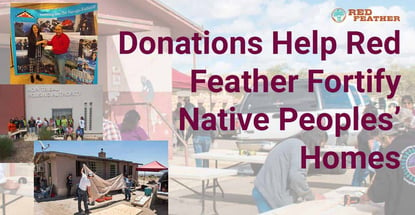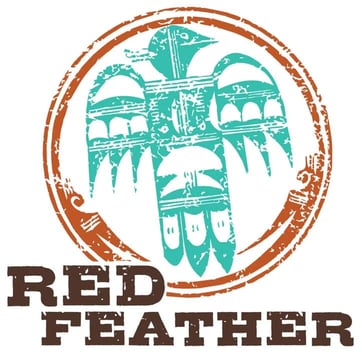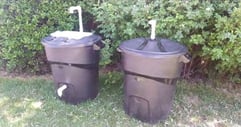
Our experts and industry insiders blog the latest news, studies and current events from inside the credit card industry. Our articles follow strict editorial guidelines.
In a Nutshell: People living on the Hopi and Navajo reservations face challenges maintaining their homes. Red Feather partners with tribal communities to help residents make repairs to their homes. The organization’s scholarships provide professional training opportunities that empower people to learn home-repair skills. Donors can support Red Feather financially and volunteer to work on improving housing conditions on reservations.
Access to home repair services and supplies is a convenience most people take for granted. When a plumbing emergency occurs, help is often just a phone call or text message away. Homeowners needing a tool or supplies to complete a home repair can go online and arrange for the item to be delivered directly to their doorstep.
But those living on reservations have a different experience. They may not have quick access to carpenters, electricians, and plumbers. Supply delivery can also be challenging, as some companies may not often deliver to reservations.
Red Feather is a nonprofit organization established in 1991 that recognizes the challenges of Indigenous communities in accessing solutions that keep their homes comfortable and secure. Red Feather began in Bozeman, Montana, with a group of volunteers who joined forces to build straw bale houses for members of Indigenous communities.

We spoke with Monica Polingyouma, Red Feather’s Program Administrative Coordinator, and Tavanne Sousa, its Development Manager, to learn more about the organization and how cardholders can support its mission.
Polingyouma said many Indigenous Americans don’t have the income required to secure a mortgage, so they don’t purchase their homes — they build them. Red Feather partners with tribal communities to help weatherize homes on reservations and make home repairs, including installing new exterior doors and windows.
Red Feather draws its name from its history. The organization’s first repair project was to a home owned by a woman named Red Feather.
Red Feather expanded its efforts in 2021 to begin serving on the Hopi reservation in Arizona. The organization extends its services to Navajo land, including areas in Arizona, Colorado, New Mexico, and Utah.
“On the Hopi reservation, the land is owned by the people,” Polingyouma said. “Those living on the reservation don’t necessarily want money from the government to assist them in establishing and maintaining their homes. They build their own homes with their own hard work and money. Then, the home is completely theirs.”
Scholarships Provide Access to Professional Training
Red Feather helps Indigenous people make their homes more comfortable, but it also takes steps to promote healthy living. Polingyouma said some Indigenous people move their families into homes that don’t have built floors. Instead, the natural earth serves as the house’s floor.
“People are fine moving into homes with dirt floors,” Polingyouma said. “But health issues can come up later down the road. That’s where Red Feather comes in to help. We can not only fix the floor in that case, but we also help a home’s inhabitants work toward having a better, healthier home. And that’s especially important when there are children or elderly people living in a home.”
Polingyouma said some homes that Red Feather assists in updating are clay or mud structures built as early as the 1950s. Many of the homes don’t have proper insulation to shield them from extreme temperatures.

“A lot of people will put all their money into building their home, but when it comes to insulation, they don’t have any money left for that,” Polingyouma explained. “Financial situations can present problems for people. There aren’t a whole lot of jobs available on reservations.”
Donors can support Red Feather’s mission. Sousa said the organization receives funds from private donors and has recently begun applying for government grants.
“The government can provide big money, but a lot of red tape comes with that,” Sousa said. “We also receive support from foundations, and some people donate trust money or 401(k) funds to us after they pass away. Any dollar we receive in donations helps.”
Interested parties can donate to Red Feather directly on its website, which lays out how donations are used. For example, the organization can use a $50 gift to install carbon monoxide and smoke detectors. A $1,000 donation can fund the installation of a solar furnace.
Red Feather uses donated funds to provide scholarships to members of the Hopi and Navajo communities. The organization’s scholarships help people obtain professional training and licensing that supports home-building efforts, including contracting and plumbing licenses.
Volunteers Assist Home-Development Projects
The Hopi and Navajo tribes help fund Red Feather’s projects via government resources they receive. Polingyouma said the organization can perform large-scale home repairs, including roof restoration, electrical panel installation, and bathroom remodeling. Red Feather focuses on solutions that help older adults, such as ramp installations that allow people to enter and exit their homes safely.
Red Feather aims to provide everyone who seeks its services with a minimum of $500 for home repairs.
“A $500 one-time gift can help people that need a new stove, water heater, or a smaller-scale repair,” Polingyouma said. “Individuals who take advantage of receiving $500 from us just need to report back to us after their repair or installation has been completed.”
Red Feather accepts applications for assistance from people in the Hopi and Navajo communities. Polingyouma said the organization prioritizes financial awards based on an applicant’s need. A Red Feather coordinator will visit the homes of individuals approved to receive funds to assess the details of their repair project.
Polingyouma said Red Feather’s staff is growing. The nonprofit also accepts assistance from volunteers.
“We get a lot of help from retired people who have construction experience and can apply that to the houses we’re working on,” Polingyouma detailed. “We also get volunteer help from youth groups.”
Helping Indigenous People Secure Their Futures
Red Feather seeks to partner with contractors who are members of the Hopi or Navajo communities and live on the reservation. Polingyouma said the Hopi and Navajo nations require businesses to obtain approval from them before they start working on the reservation. Red Feather helps outside businesses adhere to tribe-related regulations that companies must follow.
Polingyouma said it can be difficult for people to secure steady employment on the reservation. Many people leave their communities to find work, which causes them to miss the cultural events and celebrations that regularly occur in reservation villages.
Those who leave the reservation for educational pursuits face a different kind of challenge upon completing their education and returning home.
“People living on the reservation who go off to school to learn a trade return home and realize there just isn’t consistent work there,” Polingyouma said. “That’s where our scholarship program comes into play. We not only help someone get their business license but also help them to establish and grow their business.”

Polingyouma said some new Hopi businesses fail within their first year.
“Reservations have schools and healthcare facilities, but they don’t have very many small businesses,” Polingyouma said. “There’s opportunity there. It would be nice for reservations to have regular access to essential services like plumbing.”
Red Feather provides educational programs, including hosting classes on reservations to teach people how to do simple home-repair projects. Sousa said the organization’s classes also teach people how to use power tools such as saws and power drills safely.
Red Feather’s efforts to enhance the lives of those living on reservations include promoting personal hygiene.
“Many people living on reservations don’t have running water in their homes,” Polingyouma said. “So we’ve distributed hand-washing stations to help people keep clean, which has been especially important in light of COVID-19.”


![Mission Lane Credit Card Preapproval ([updated_month_year]) Mission Lane Credit Card Preapproval ([updated_month_year])](https://www.cardrates.com/images/uploads/2022/05/Mission-Lane-Credit-Card-Preapproval.jpg?width=158&height=120&fit=crop)


![What Is Netspend? The Company & Its Products ([updated_month_year]) What Is Netspend? The Company & Its Products ([updated_month_year])](https://www.cardrates.com/images/uploads/2022/10/What-Is-Netspend.jpg?width=158&height=120&fit=crop)

![6 Credit Strategies to Help You Financially Prepare for the Holidays ([current_year]) 6 Credit Strategies to Help You Financially Prepare for the Holidays ([current_year])](https://www.cardrates.com/images/uploads/2019/10/Holiday-Credit-Strategies-Feat.jpg?width=158&height=120&fit=crop)

![3 Credit Cards For Kids & Ways to Help Them Build Credit ([updated_month_year]) 3 Credit Cards For Kids & Ways to Help Them Build Credit ([updated_month_year])](https://www.cardrates.com/images/uploads/2022/03/Credit-Cards-For-Kids.jpg?width=158&height=120&fit=crop)